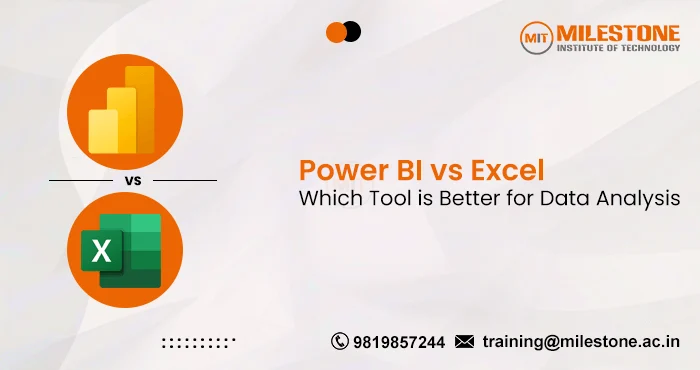When it comes to making quality decisions, effective data analysis is most essential in today’s data-driven world. While there are many tools available for data analysis, the two most powerful and demanding tools that rule the industry are Excel and Power BI. They have unique features and capabilities which are used for different tasks. We will discover the key differences between Power BI and Excel which are majorly searched as
Power BI vs Excel. We will also be covering the strengths and all the essential points to make better choices between both of these tools.
What is Power BI?
Power BI, developed by Microsoft, is a robust business analytics tool that enables users to visualize and share insights from their data. It offers a suite of interconnected tools for data transformation, visualization, and sharing. Power BI is known for its ability to handle large datasets and create interactive reports and dashboards effortlessly.
What is Excel?
Excel, also developed by Microsoft, is a widely used spreadsheet application that has evolved into a powerful tool for data analysis. It allows users to organize, manipulate, and analyze data using formulas, functions, and pivot tables. Excel is renowned for its versatility and familiarity, making it a go-to choice for data analysis among professionals across various industries.
Understand Differences Between Excel and Power BI (Power BI vs Excel)
| Aspect |
Power BI |
Excel |
| Data Handling |
Power BI has been created to manage complicated data transformations and manage large datasets.It facilitates advanced data modeling and analysis, and it may establish connections with several data sources. |
Excel works better with smaller datasets and easier computations. It works well for basic data analysis and is widely used for spreadsheet tasks and calculations. |
| Visualization |
When it comes to producing dynamic and interactive visualizations like graphs, charts, and maps, Power BI is would be the best choice. |
Excel offers basic to intermediate charting and graphing capabilities. While versatile, it may not provide the same level of interactivity and visual appeal as Power BI. |
| Collaboration |
Power BI allows for easy sharing of reports and dashboards across teams and organizations through its cloud service, Power BI Service. It supports real-time collaboration and data-driven decision-making. |
Although Excel files may be shared, there are fewer options for collaboration than Power BI. Multiple users can edit a file simultaneously via cloud-based services like OneDrive or SharePoint. |
| Automation |
Power BI provides robust data modeling capabilities, including relationships, calculated columns, and measures, enabling complex analysis and insights generation from structured datasets. |
Excel users may automate repetitive tasks and develop custom functions for data processing and analysis by utilizing macros and VBA programming. |
| Data Modeling |
Power BI provides robust data modeling capabilities, including relationships, calculated columns, and measures, enabling complex analysis and insights generation from structured datasets. |
Excel supports data modeling to a certain extent with features like Power Pivot and Power Query, but it may not handle large datasets or complex relationships as efficiently as Power BI. |
| Real-Time Data Analysis |
Power BI can connect to live data sources and provide real-time insights and updates, making it suitable for businesses requiring up-to-the-minute analytics. |
Excel can handle real-time data to some extent but may require manual refreshing of data connections for updates. |
Key Features and Capabilities
Power BI:
- Advanced data modeling with relationships and DAX (Data Analysis Expressions) formulas.
- Interactive dashboards and customizable visuals.
- Natural language querying with Q&A feature.
- Integration with Azure services and third-party applications.
Excel:
- Advanced functions and formulas enabling thorough data analysis and efficient data manipulation.
- Pivot tables and charts for summarizing data.
- What-if analysis and scenario planning tools.
- Integration with other Microsoft Office applications.
Best Use Cases
Power BI:
-
- Business intelligence and analytics for large organizations.
- Complex data modeling and predictive analytics.
Excel:
- Ad-hoc data analysis and quick calculations.
- Financial modeling and budgeting.
- Small-scale data visualization and reporting.
Which is the Best Tool Between Power BI and Excel?
The choice between Power BI and Excel depends on your specific requirements:
- Choose Power BI for: Large datasets and complex data modeling, Interactive and real-time reporting, Collaborative analytics across teams.
- Choose Excel for: Small to medium-sized datasets and quick analyses, Familiarity and ease of use for individual users, Ad-hoc reporting and simple charts.
Where to Learn Power BI and Excel?
To master Power BI and Excel, consider enrolling in courses offered by Milestone Institute of Technology. They provide comprehensive
data science and data analytics training programs that cover both tools extensively, equipping you with the skills needed for effective data analysis and visualization.
Frequently Asked Questions (FAQs)
Can Power BI replace Excel?
Power BI complements Excel rather than replacing it. Excel is still necessary for on-the-spot analysis and tiny datasets, even if Power BI shines at interactive reporting and large-scale data processing.
Is Power BI easier than Excel?
Power BI may have a steeper learning curve initially due to its advanced features for data modeling and visualization. However, both tools offer user-friendly interfaces tailored to different analytical needs.
Which tool is better for financial analysis: Power BI or Excel?
Excel is often preferred for financial modeling and budgeting due to its familiarity and robust calculation capabilities. Power BI is more suited for visualizing financial data across large datasets and creating interactive financial dashboards.




